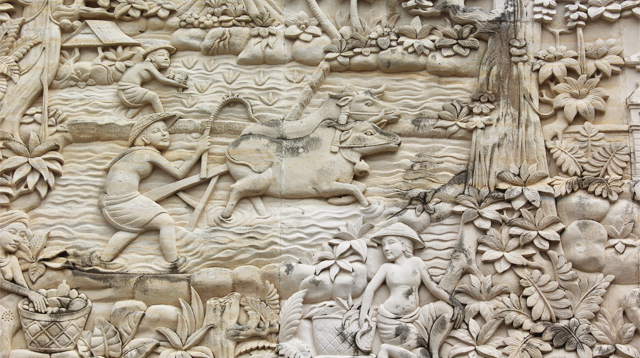DUBBED as the Island of the Gods, Bali is not only renowned for its stunning beaches and vibrant culture but also for its rich artistic heritage. Among the myriad art forms that grace this tropical paradise, Balinese relief carving stands out as a testament to the island’s deep-rooted cultural traditions and artistic prowess. Let’s delve into the captivating history of Balinese relief carving and discover the stories etched into the stone.
Ancient Origins
The art of relief carving in Bali dates back centuries, finding its roots in the island’s Hindu-Buddhist influences. Carved into stone or wood, these intricate reliefs depict scenes from ancient epics, mythological tales, and religious narratives. The earliest examples can be traced to the majestic temples of Bali, where skilled artisans chiseled away to create stunning visual narratives that adorned sacred spaces.
Sometimes, the inspiration is also taken from daily activities, such as agrarian culture depicting the activities of farmers in cultivating their lands. Infrequently, there are also themes taken from local mystical belief.
Religious Significance
Balinese relief carving has strong ties to spirituality and religious practices. Temples such as the iconic Besakih and Uluwatu showcase elaborate carvings that narrate the tales of Hindu epics like the Ramayana and Mahabharata. These carvings serve not only as decorative elements but also as visual aids, educating the faithful on the teachings of their religion.
Symbolism and Aesthetics
Every carving tells a story, and behind each intricately carved detail lies symbolism and deeper meanings. The lush foliage, celestial beings, and mythical creatures all play a role in conveying cultural, moral, and spiritual messages. The aesthetics of Balinese relief carving are characterized by fluid lines, dynamic compositions, and a keen attention to detail, creating visually stunning masterpieces.
Master Artisans
The art of relief carving in Bali is passed down through generations, with master artisans preserving and evolving this ancient craft. These skilled craftsmen often work within family workshops, where knowledge is shared and techniques are honed over years of practice. Today, Balinese relief carving continues to thrive, blending traditional methods with contemporary expressions, ensuring its relevance in the modern artistic landscape.
Preserving Heritage
While modernization has brought about changes to Bali, the commitment to preserving cultural heritage remains strong. Efforts to safeguard and promote the art of relief carving include workshops, exhibitions, and collaborations with contemporary artists. This ensures that Balinese relief carving continues to be a living tradition, appreciated by both locals and visitors alike.
Balinese relief carving is more than just a form of artistic expression; it is a living testament to Bali’s rich cultural tapestry. As these masterpieces continue to grace temples, palaces, and galleries, they not only showcase the island’s artistic prowess but also narrate the timeless stories that have shaped Bali’s identity. The intricate dance between chisel and stone is a celebration of history, spirituality, and the enduring beauty of Balinese relief carving.










